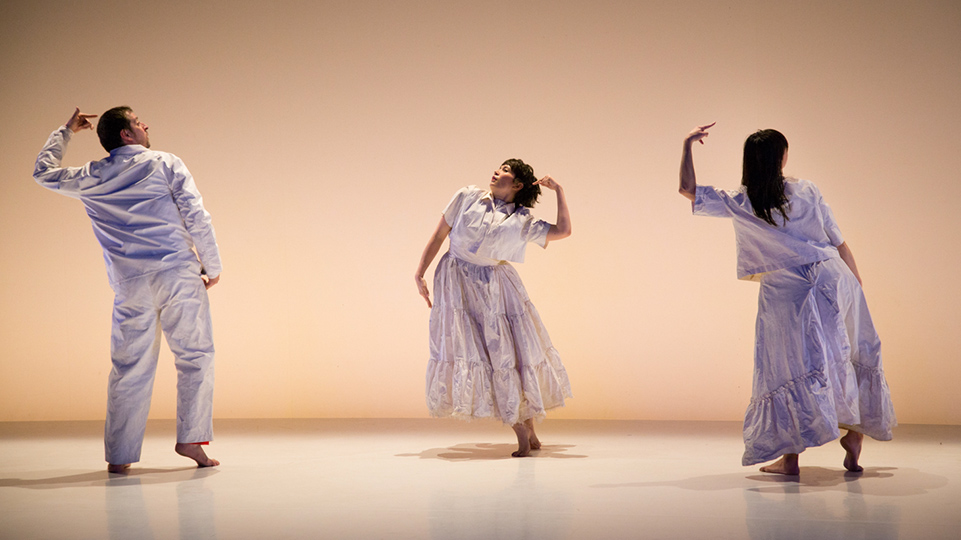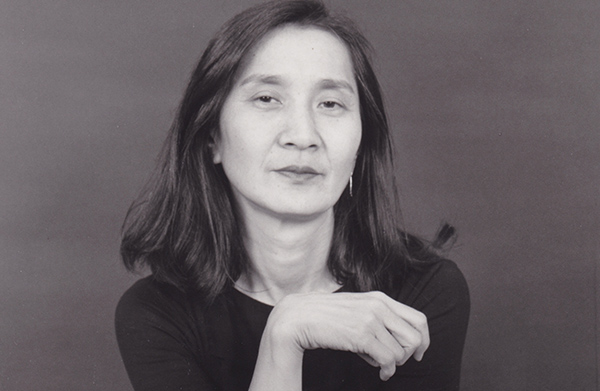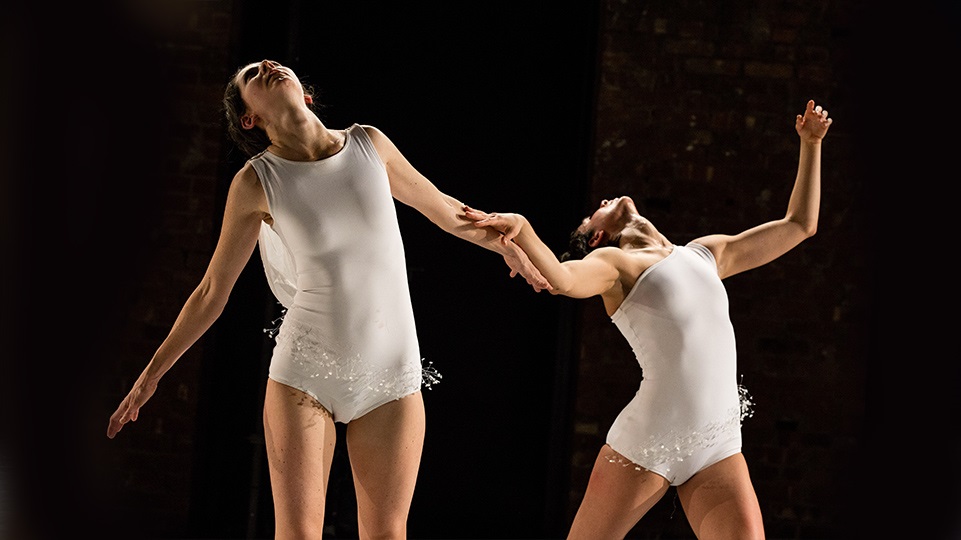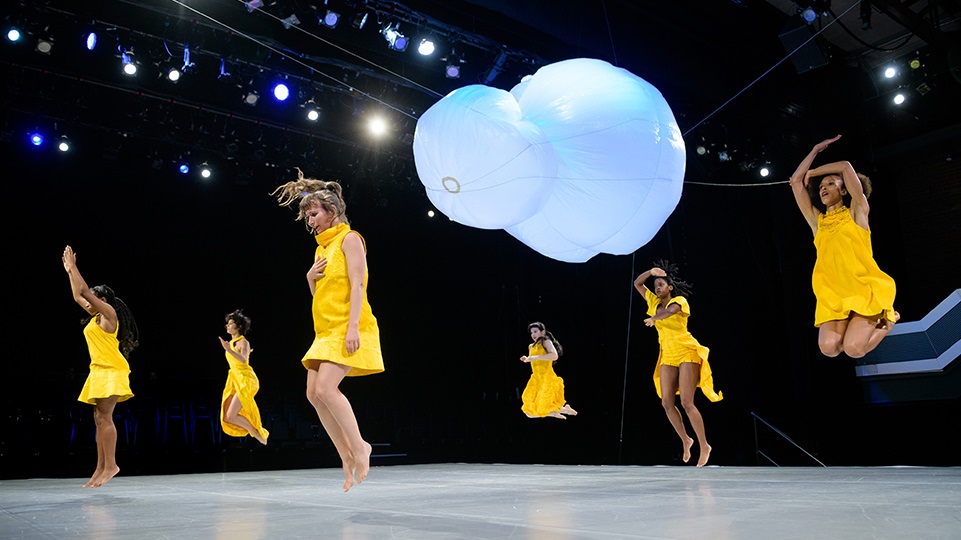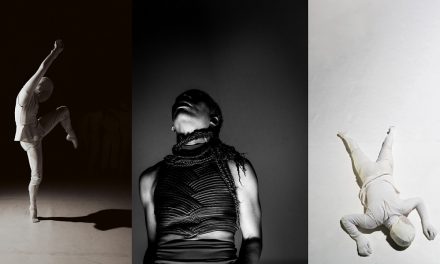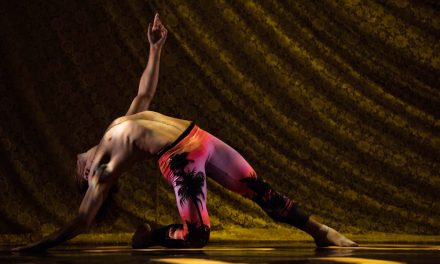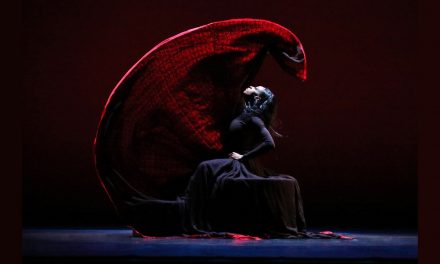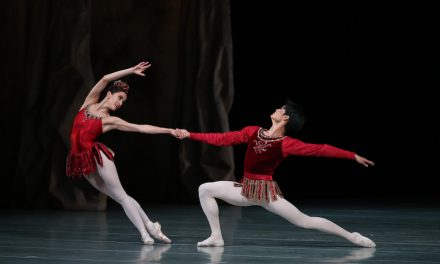In the late 1970s, while teaching a technique class as a guest dance faculty member for one quarter at University of California, Los Angeles I met a young and very talented dancer, Donna Uchizono, who would later transfer to California State University, Long Beach (CSULB) to earn her Bachelor of Arts degree in Dance. I had just moved to California after living and performing in New York City for over ten years and decided to launch my own dance company Jeff Slayton & Dancers (JS&D) while teaching part-time at CSULB. Uchizono was a founding member of that company and performed with JS&D until I closed its doors in 1984. She relocated to New York City in 1986 and was soon making a name for herself as a choreographer in what is known as the downtown dance scene. She founded Donna Uchizono Company and today Uchizono is a highly respected dance artist whose work has been presented nationally and internationally.
Although we have only seen each other twice since, I have followed Uchizono’s career closely. When I learned that her new work Wings of Iron will be co-presented by the Baryshnikov Arts Center (BAC) and the Chocolate Factory Theater on May 18-21, 2022, at the BAC , I felt that I needed to set up an interview. Due to her heavy schedule it took a while for us to connect, but we finally met on Zoom and for over two hours Uchizono and I caught up on decades of each other’s life journey since JS&D.
Before we began the formal interview, Uchizono mentioned that she would be coming to CSULB for one week in August to re-stage one of her works to be performed in November of this year. This is an extremely short time and during this discussion she revealed a bit of her choreographic process.
“All my pieces are very different,” she began. “because I use the piece to determine what the physical vocabulary is. I don’t come in with a movement vocabulary but I come in with an idea or concept, and that’s what drives. So, the vocabulary is very specific for this piece” After Uchizono leaves, the dance titled State of Heads will be rehearsed by the department’s full time faculty member Keith Johnson.
In 1988 another CSULB alumni, Nikki Castro, moved to NYC and began dancing with Bebe Miller’s company. Uchizono was auditioning and Castro said, “Donna, you’re a choreographer. Stop dancing for other people.” Uchizono was hesitant because no one knew who she was, Castro agreed to perform in her work. Along with a few other dancers, she rented Danspace Project through their community access. Bebe Miller came to see Castro perform, Uchizono’s roommate Becky Hilton and other members of the Stephen Petronio Dance Company went to see her work. She received praise and encouragement from Miller and a few of the Petronio dancers followed by a few from Nina Weiner’s company asking if they could be in her next piece. Others like Ralph Lemon, Richard Elovich from Movement Research and Terry Fox, the director at the time of Danspace Project. From the first performance Uchizono was offered half an evening at both Movement Research and Danspace Project.
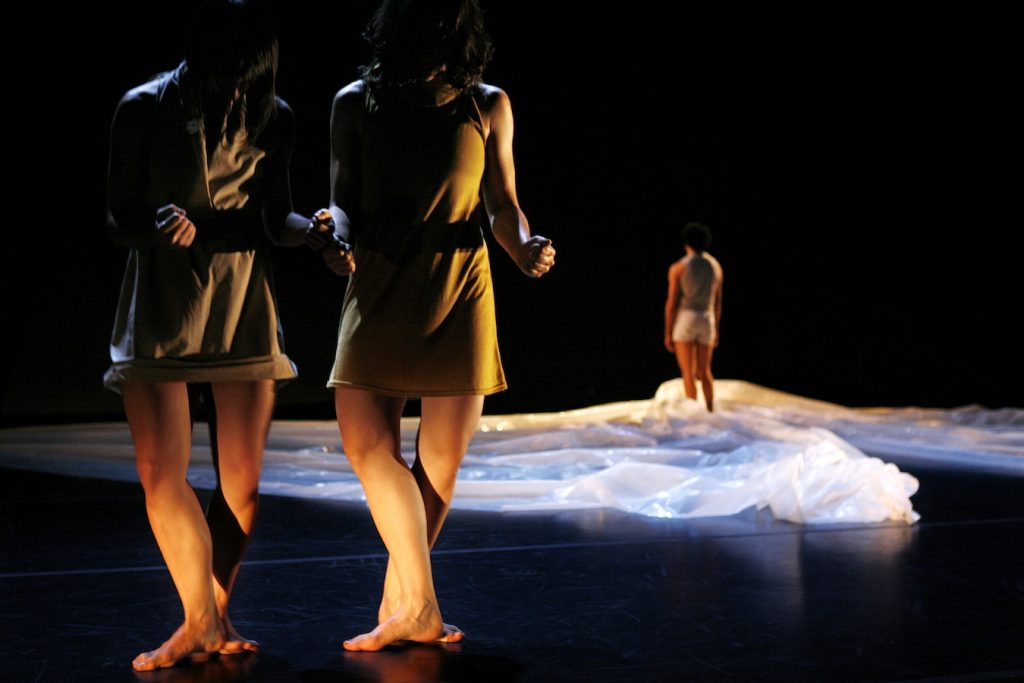
Donna Uchizono Company – “Thin Air” (2007) – Dancers Histoula Harakas, Julie Alexander, Antonio Ramos – Photo by Julieta Cervantes
Following a very small review in 1989 by dance critic Deborah Jowitt in the Village Voice, Uchizono received a phone call from The Kitchen offering her a full evening the following year. The work that she produced for that full evening at The Kitchen was titled San Andreas. A year later Uchizono received a fax from Vienna inviting her company to perform. They asked her to have her manager send them information about her company and her touring fees.
“I was like, what company, what manager, what touring fees?” she said laughing. At the time Uchizono was living in a six floor walkup tenement building on 7th Street between Avenues C and D. That area is now high real estate, but in 1990 it was definitely not. “That is how it all started,” she added. “but we did not incorporate until 2001.”
At the height of her company’s touring, Uchizono worked with the same dancers on most of her projects. During that time, she also entered into the adoption process but it was not until almost 15 years later, in 2011, that she was told that they had a three year old girls for her in Nepal. She was concerned that she was now too old but was told by the adoption agency that love was love.
She decided after all that waiting to go ahead with the adoption. “Jeff,” Uchizono said. “I had been pregnant for 15 years!” She decided to continue with the adoption and travelled to Nepal to begin the paperwork to bring her young daughter home to New York. For some reason, the child would not speak. She cried and laughed, so Uchizono knew that she could make sounds. During the time she was in Nepal she began calling her soon to be daughter my little start in Nepalese and one day when someone asked what her name was, the child took her fingers out of her mouth and said “Tara.”
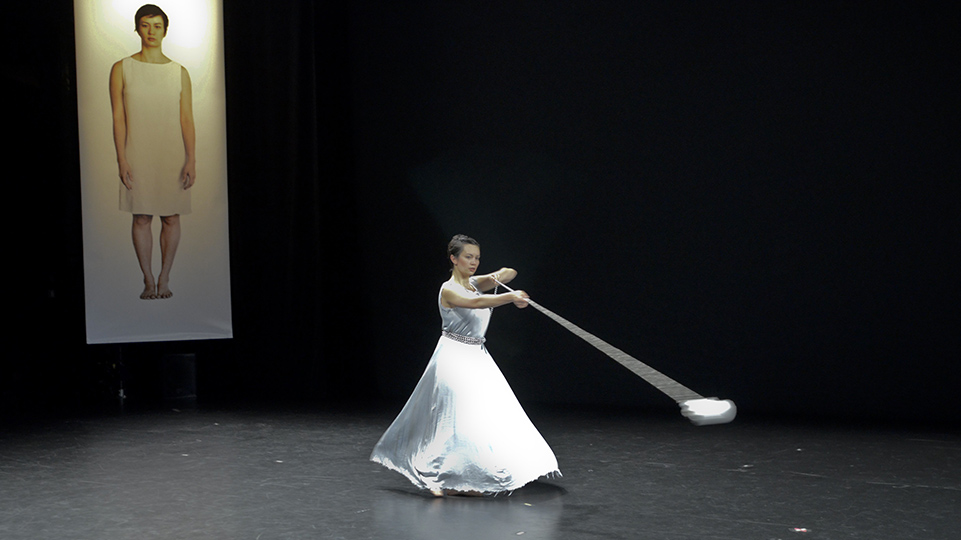
Donna Uchizono Company – “Fire Underground” (2014) – Dancer Rebecca Serrel Cyr – Photo by Ian Douglas
Presently, Uchizono is busy beyond harried. “I’m single mom, I’m running a dance company and I’m teaching full time,” she said. “So that is why I said that my schedule was just insane.” On top of all that one of her mentees just presented her thesis work. “Now my schedule goes from inhumane to crazy!” Uchizono added.
During my research before connecting with Uchizono for the interview, I kept coming upon a phrase that she uses while describing her choreographic process, “…dedicated to charting new territory with each dance, my process involves hearing the work.” I asked Uchizono to explain.
Uchizono described how she enters the studio with an idea or ideas that are on her mind – not necessarily movement ideas but thoughts. She used her popular work State of Heads as an example. It is a dance that many have asked her to restage for their company or institution, including CSULB.
“It was made in 1999, before the year 2000 and Y2K when we didn’t know what was going to happen,” she said. “We were hoping that the new administration would be positive. At the time I felt that the heads of state was disembodied from the body of the country.” She went on to describe how she asked her dancers to experiment with moving their bodies while keeping their head in one place. “I always think that my ideas are points of departure rather than what the piece is about,” she continued. “I feel that there are undercurrents that want to be heard and that know more than I do, so I lay down the idea.”
Uchizono and her company then explored movements where the body moved and the head remained still, as the heads of state being disembodied from the country, their heads were disconnected from their bodies. “And then something else started to emerge which I wouldn’t have known had I been going straight into what my idea was,” Uchizono said, adding that she felt that she was not smart enough to produce the perfect idea, but that the muses and the undercurrents do. “The problem is that sometimes it takes them longer to talk; they tend to whisper,” she said tilting her head into a listening posture, “What? And sometimes they take you on tangents and I ask are you sure? You really want to go there?” Uchizono continued. “I feel like I have a dialogue – and it’s not that I don’t ever say anything back,” she said smiling.
She described to me that what was beautiful about State of Heads, was that three odd characters began to emerge, one of them Uchizono. For the first time rather than performing with others her own age she was older than the other two dancers in the work. “We were these very odd but innocent characters who didn’t even know that we were being moved by these political tremors that were happening,” she said. To the audience the work appeared innocent and fun, but for Uchizono underneath it was something darker and more sinister. State of Heads is also about waiting, i.e. waiting to see what happens with computers as the world entered a new millennium and a new administration.
“So, I had gone in with a very specific idea to start generating the movement material,” Uchizono reiterated. “but then I feel that part of it (creating the work) is what I call being an intuit. I have a dialogue with the piece rather than me telling it what the piece is about.” In her choreography classes, Uchizono tells students that the dance can help them with the structure; that if they pay attention there is choreographic honesty your dance demands. If they are thinking of including extra jumps or leaps to simply make it more exciting, the dance just might say no. Uchizono knows that this process takes longer and that it can be uncertain, but it is one that has definitely been successful for her.
In 2011, the Cultural Heritage Coalition contacted Uchizono saying that they had deemed her a master choreographer and as part of a funded project they were reaching out to choreographers whose work they felt should be archived for the New York Public Library for the Performing Arts (NYPL), and that they wanted to digitize ten of her works to begin the process. Currently her work has not been included at the NYPL because the Cultural Heritage Coalition closed and Uchizono’s files were sent to the (USC). USC is also the home of the Gloria Kaufman School of Dance.
In a statement put out by the Donna Uchizono Company she wrote, “I enter the next important step–Phase I–working closely with archivist Cori Olinghouse in an archival methodology that explores how embodied dance practices are transmitted. Entailing an intensive excavation of my work, we are mapping out concepts and practices embedded in my artistic research. Phase 2 (pending funding) will expand on ideas of listening as embodied in my practice, inviting memory workers MiRi Park, and Suzanne Snider, artists with deep listening practices that intersect with methods of archiving, for conversation and workshops for myself and company dancers.”
While Uchizono was applying for an Archival Preservation Grant, and after a year of investigation, it was discovered and verified by the NYPL that Uchizono is “the first and only American-born choreographer of Asian ancestry in the history of Modern Dance to have received the recognition of both cumulative esteemed national grants and significant national and international touring of an eponymous dance company.”
According to Baryshnikov Art Center’s publicist, “this designation recognizes receipt of a Guggenheim Fellowship, United States Artist Award, National both Endowment for the Arts Company Project Awards (9) and Fellowships (3), MAP Fund (4), Alpert Award, “Bessie” New York Dance and Performance Award, Jerome Foundation (3), both National Performance Network Commission (4) and Touring support (4) Creative Capital, both National Dance Project Commission (2) and Touring support (2), Dance Magazine and Metropolitan Life, among many other awards including extensive New York State and New York City sustained funding.
While discussing this, Uchizono told me that she had been looking for a mentor to help her with the process of applying for the above mentioned grant. Other than a few choreographers who are black, she could not find another like herself. An American woman of Japanese ancestry born in the States, who does not speak Japanese, who is part of the postmodern lineage and who could guide her through this process. Sara Nash from the NEA thought surely there must be someone.
“I hope so,” Uchizono said to Nash. “because I don’t know of any.” The well-known Japanese choreographers such as Eiko Otake and Takashi Koma Otake (Eiko & Koma) were born in Japan. “I was born here, I was kicked, I was spit on,” she continued. “I grew up as an America but was never treated as an American by many people.” Sadly, this continues to be the case.
She did not want to believe it and her colleagues had a difficult time believing her. But indeed, it is true that Uchizono is the first and only American born choreographer of Asian heritage that has received the kind of recognition through awards and touring nationally and internationally. At first this knowledge sent Uchizono into a deep depression. “No one wants to be the first and only,” she said. “it’s a very lonely journey. It’s incredibly lovely.” Once the upcoming performances at BAC are over, Uchizono will be speaking to presenters to bring this very sensitive subject to their attention.
“I feel like this is what I need to talk about,” she said. “I don’t like promoting myself. It was hard enough promoting my work, let alone myself.” Uchizono is extremely grateful for all that she has been able to accomplish and the awards that she has received but feels compelled to speak up for other artists who might be of Asian heritage but were born in this country and do “American work.” The fact that she is the first and only American born Asian who has received these accolades is an indictment on dance and those who promote it, and the fact that attacks against Asians throughout American have risen by 246 percent in the last year is one more reason for Uchizono to bring attention to this problem.
“Within the field I am and have always been identified as a “choreographer” without the self-identification or specificity of my race. In general terms, for this current landscape, I use the term Asian-American to mean any Asians because I feel I need to have solidarity with anyone who is Asian in America whether they were born here, naturalized or just arrived. But as I go forward
talking to various people in the dance field about my “distinction”, I use the specific language “American-born of Asian ancestry to bring focus to the ramifications my “distinction” betrays.” Uchizono said.

Donna Uchizono Company – “March Under An Empty Reign” (2018) – Dancers Natali Green, Aja Carthon – Photo by Ian Douglas
Uchizono began to work on her new work, Wings of Iron, in 2016 and it was scheduled to be presented at BAC in May of 2020. The pandemic, however, altered all that. She told me that this piece began for her after hearing Gwendolyn Brooks read a poem about social worker, feminist and internationalist Jane Addams. The poem, titled “Jane Addams,” begins “In these giant-less times…” and refers to Addams as giant Jane. Uchizono used to think of her friend and colleague Nikki Castro as her “giant Jane” and, along with Castro, created a work by that title.
“I think that the giants in my world are the dancers,” Uchizono said. “The dancers are the weakest economic link in our field and they do so much!” While thinking of the work, which was originally called Iron Jane, she thought of dancers as the wings of humanity and the only thing that keeps them earthbound is the weight of their humanity is like the weight of iron. The art of dancing is ephemeral and these angels move amongst us providing elements of healing and joy that are opposite of what else is produced via capitalism.
“I also think that what we do is a gift to the world,” she said. “At least is the only thing I know how to do.”
Not wanting to give too much away, Uchizono was reluctant to say more about Wings of Iron and as someone who has made dances, I totally respect that and will honor her request. I will, however, quote some of what she wrote. “Developing this work in our times has made me especially sensitive to moments that remind us of our humanity, moments that lead us towards a common understanding in a divisive cultural and political moment. Within the canon of postmodern dance, Wings of Iron provides a forum to share in the weight of a vulnerability that is simultaneously public and private and charts new territory for audience engagement that emphasizes ethical care for the vulnerability of an audience participant during a live performance. I open the dance by asking, “If you were to dedicate a dance to someone, who would that person be?.”
Choreographed by Uchizono in collaboration with performers Bria Bacon, Natalie Green, Molly Lieber, and Pareena Lim, Wings of Iron features an original score by composer okkyung lee and lighting design by Joe Levasseur.
Uchizono is not just an excellent choreographer. She is a very intelligent woman and someone who has great empathy for others. She notices what is going on around her and turns it into art. Luckily for those of us in this field, the art form Uchizono has chosen is the art of making dance.
The interview with Donna Uchizono lasted two hours and twenty-one minutes and I could continue to write about this incredible woman but have said enough for now. I am so grateful that she made space for me in her very busy schedule of running a company, teaching at Florida State University and being a great mom to Tara.
Wings of Iron will be presented at Baryshnikov Arts Center May 18-21, 2022 at 7:30pm. For more information and to purchase tickets, please visit the Baryshnikov Arts Center website HERE.
For more information on the Donna Uchizono Company, please visit their website.
Written by Jeff Slayton for LA Dance Chronicle.
Featured image: Donna Uchizone Company – State of Heads (1999) – Dancers (L-R) Levi Gonzales, Rebecca Serrell Cyr, Hristoula Harakas – Photo by John Cyr
Please follow us on Facebook, and on Instagram and on LinkedIn and on Twitter.
Please consider donating to LA Dance Chronicle HERE.

